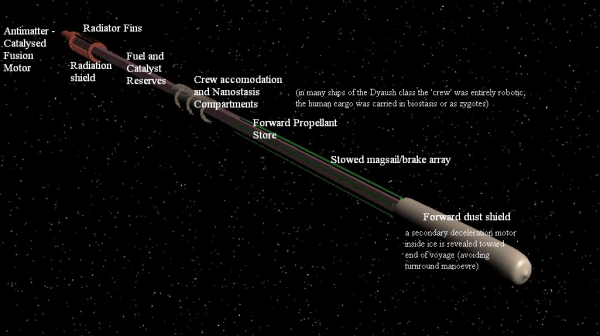BY LETTER
Dyaushpitr Interstellar Colony Ship
Technology > Application > Transportation > Ships > Classic Ships
Culture and Society > Cultural Factors > Interstellar Colonization
Technology > Application > Transportation > Interstellar Transport
Culture and Society > Cultural Factors > Interstellar Colonization
Technology > Application > Transportation > Interstellar Transport
 Image from Steve Bowers | |
| Click for larger image | |
The earliest interstellar colony ships used a range of propulsion systems, mostly augmented by primitive boostbeams to reduce the mass of on-board fuel. After the Technocalypse, the Goddess of Earth, known as GAIA, appropriated both the boostbeams and the antimatter production facilities for security reasons, and all launches stopped. Following the Last War on Earth and the Great Expulsion, GAIA reactivated these facilities in order to facilitate a great diaspora from the Solar System. After this time interstellar migration slowed to a trickle, as She was no longer willing to assist with the process for reasons that are not clear. Eventually the First Federation was declared, and started to construct independent boostbeams and antimatter facilities, under Her watchful but taciturn eye.
Launched in 943 AT, the Dyauṣpitṛ (Dyaushpitr), the first colony ship directed toward Eta Cassiopeia, was a combination of several different technologies, and successfully reached its destination 94 years later. The Dyaushpitr was fairly typical of the craft launched in the first years of the Federation, and was the first member of a numerous class of similar ships, which were almost all seedships carrying zygotes or DNA data.
Launched from Surya, a vulcanian class asteroid near the Sun, the 2.5km long, pencil thin [Dyaushpitr was constructed almost entirely from carbon-fibre reinforced cometary ice. For several years the solar powered terawatts laser banks of the Keralan Power Combine had been creating matter/antimatter pairs in huge amat farms and sorting, combing and storing the antimatter using magnetic fields. Several tonnes of frozen antihydrogen were carried by the Dyaushpitr to catalyse the amat/ fusion reaction drive, with an iron shell surrounding the centrally placed payload, protecting it from gamma radiation.
The payload included thousands of frozen human zygotes. and a collection of synthetic human robots known as Parental Vecs, intended to nurture the new-born humans at the colony. Over time the new-born humans would either displace the synthetic Parentals, or develop a hybrid culture. The limited agricultural genetic library available to the Keralans was also included.
On launch, the Dyaushpitr briefly fired its amat/fusion motors to enter a low energy transfer orbit to Mercury, then executed a slingshot manoeuvre around Venus and Jupiter. Leaving the plane of the solar system using the gravity of that giant planet the ship coasted until it was two million kilometres above the ecliptic, then extended a magnetic drive sail many tens of kilometres in diameter. A series of smart particle-beams based on various moons of Jupiter (owned by the Keralan Power Combine in this period) now accelerated the craft by exerting pressure against the extended sail. These Keralan boostbeams were used to launch many thousands of interstellar craft in this period, and the amat combine became one of the most powerful political players in the Solar System.
After eight months of acceleration in this fashion, Dyaushpitr now began to accelerate using anti-matter catalysed fusion, with each three hundred kg of hydrogen extracted from the water ice activated by 0.1 kg of amat in the main fusion/amat reaction. This fusion reaction then expelled steam as reaction mass, gradually consuming the icy body of the craft, the steam produced introduced as an outer cooling jacket for the fusion reaction and producing a little more efficiency in the conversion of matter to thrust. Periodically left-over oxygen and carbon from the ice and support structure were fused at a higher temperature, and the ship grew shorter until the drive was extinguished at a velocity of just over 0.2c.
As the craft coasted into interstellar space, its long cylindrical iceshield was eroded by contact with interstellar dust and molecular gas at high speeds. A scanning lidar watched out for larger particles, giving minutes of warning for avoiding action to the unsleeping crew of synthetic humans. A side effect of the strong laser scan was excitation of much of the interstellar material, allowing a certain amount of deflection by magnetic shields.
At 1.5ly from Eta Cassiopeia the ice shield was nearly eroded, and the reconfigured drive sail was used as a magbrake to slow the much lighter ship down on approach to its destination. As the ship hit the heliopause of Eta Cassiopeia B, an orange K7 dwarf, a magnetoplasma parachute was extended, and a small amount of velocity was also transferred to this star in a reverse slingshot orbit. 50 AU from the B star was the A star, Achird, which the ship approached with reaction drive and parachute as brake.
Using such a sacrificial structure for the construction of the ship allowed the relatively small payload vessel to move around the target system with little requirement for fuel.
Although the Parental Vec seedship strategy did not work quite as intended at Eta Cassiopeiae (Diwali), it was successful elsewhere (as at Uoaguanyu). Many broadly similar ships were built, some using RAIR and Seeded RAIR drives instead of sacrificial ice construction, and often with hundreds or thousands of colonists in Nanostasis, rather than using the Parental strategy employed on the Dyaushpitr. The centuries after the establishment of the First Federation saw several million humans leave Old Sol for the new worlds of what later became the Inner Sphere.
Image from Steve Bowers |
Related Articles
Appears in Topics
Development Notes
Text by Steve Bowers
Initially published on 05 November 2003.
Ship images added before 2009, with minor updates to the article in 2018
Initially published on 05 November 2003.
Ship images added before 2009, with minor updates to the article in 2018






